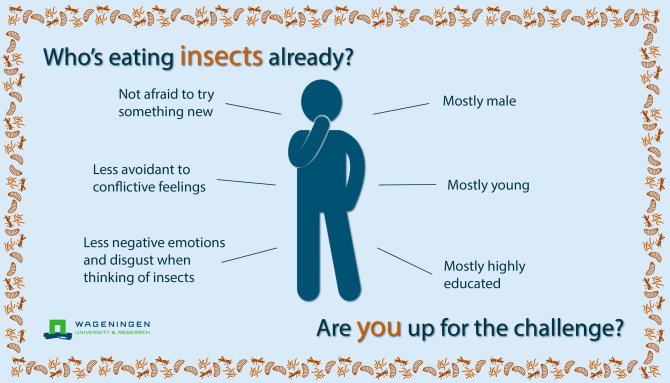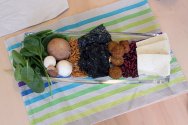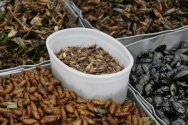
Dossier
Insects as food and feed
New protein sources are urgently needed to meet the increasing demand of the world’s growing population. Traditional meat production requires a lot of space and natural resources. Alternative, sustainable protein sources, such as insects, can contribute to a solution to this problem. Wageningen University & Research is investigating the potential of insects as a source of protein for human food and animal feed.
Insects as food
Worldwide, approximately 2100 species of insects are edible for humans. Because they can breed and grow quickly, there are important opportunities for insects as an alternative source of protein. The nutritional value of insect ‘meat’ is comparable to that of meat from traditional livestock. However, for the production of one kilo of edible product, cold-blooded insects need much less food than warm-blooded livestock. In addition, the greenhouse gas emissions from insects are up to one hundred times lower than those from pigs or cattle. This makes insects a sustainable and economically interesting solution for part of the world food problem.
More information
Projects
Contactpersons
-
prof.dr. M (Marcel) Dicke
Laboratory of Entomology -

prof.dr.ir. A (Arnold) van Huis
Laboratory of Entomology -
dr.ir. ME (Marieke) Bruins
Wageningen Food & Biobased Research -
dr.ir. CMM (Catriona) Lakemond
Food Quality and Design -
dr. MC (Marleen) Onwezen
Consumer behaviour (Wageningen Economic Research)

Insects as animal feed
Both the food industry and the animal feed industry are interested in alternative sources of protein. Research has shown that the nutritional value of insects is at least comparable with the nutritional value of soya beans and fish meal products. Feed from insects can play a major role in making the food chain circular. This is because insects can be grown on by-products and residual flows from the agrifood sector and on livestock manure. As a result they can contribute to sustainable livestock farming. Wageningen University & Research is conducting research into the possibilities of using insects as animal feed.
- Unfortunately, your cookie settings do not allow videos to be displayed. - check your settings
Food safety
As with chicken and pork, insect ‘meat’ could pose a danger to food safety. Insects can potentially transmit bacteria that originate from contaminated insect feed. Furthermore, any heavy metals and pesticides in insect feed could also end up in the insects themselves. Recent research has also shown that certain insect species carry the same allergens as dust mites and crustaceans. As a result, people who are sensitive to dust mites and crustaceans could also experience an allergic reaction from eating these insects. These examples clearly show that more research is needed to discover any dangers from using insects in food.
- Unfortunately, your cookie settings do not allow videos to be displayed. - check your settings
European legislation
Insects as 'novel foods'
Since January 1st 2018, foods with insects have been categorised as 'novel foods' according to European legislation. This means that products with insects can enter the European market only after they have been approved by the European Food Safety Authority (EFSA).
The first positive evaluation report was published by EFSA in January 2021, concerning the yellow mealworm (Tenebrio molitor). It was concluded that the consumption of the powder or whole insects would not raise any safety concerns. It was noted that these insects may cause an allergic reaction, and more research into this issue was recommended. The final step before this product is fully approved, is a change in the legislation. The EU Member States agreed in May 2021, and legislation permitting the sale of this product was introduced in June. It is expected that other insect ‘novel foods’ will follow soon.
Insects in animal nutrition
Since 2017, the use of insects in animal feed for fish farming has been permitted in Europe. Before that time, insects could only be fed to pets - such as reptiles, dogs or cats - and after processing the fat from insects could be used in feed for pigs and chickens. In September 2021, a legislative change was approved that permits the feeding of processed insect proteins to pigs and poultry. Discussions are ongoing on expanding the options for feeding insects; for instance former foodstuffs containing meat or fish, or catering waste, but at this time no concrete steps have been taken on this.



